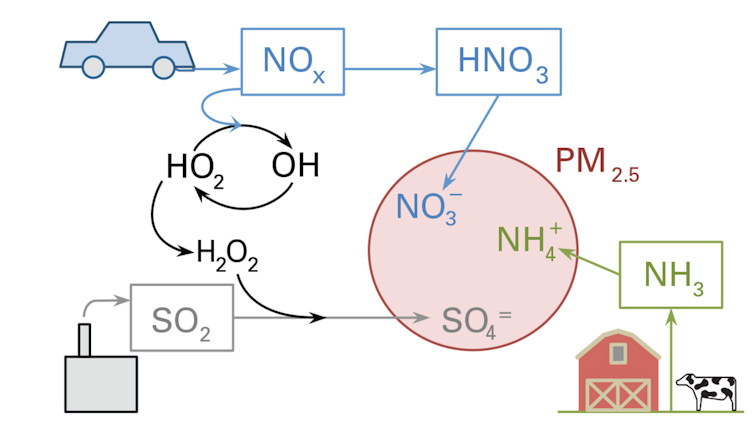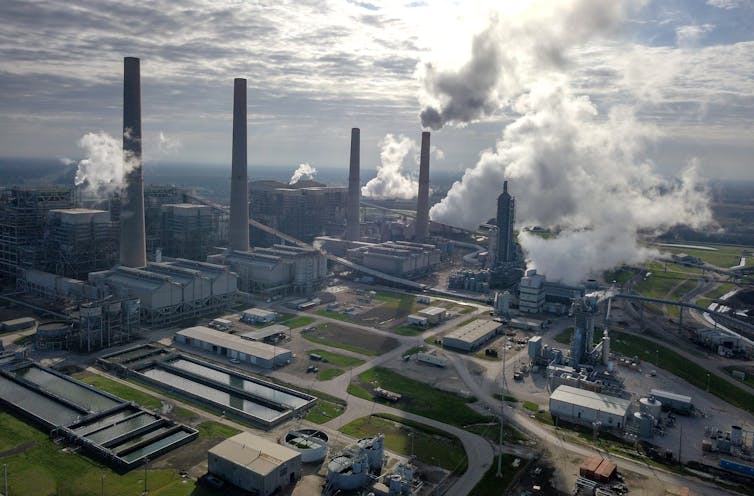EPA has tightened its target for deadly particle pollution − states need more tools to reach it

Tens of millions of Americans, including many Texans like me, live in counties that will soon be violating air pollution particle standards for the first time. It’s not that our air is getting dirtier – it’s because the U.S. Environmental Protection Agency just tightened its cap on the deadliest air pollutant: fine particulate matter, or PM2.5.
The EPA acted because the Clean Air Act requires it to periodically review existing standards for six major air pollutants to ensure that the targets protect public health. Its 2022 scientific review showed that fine particles increase rates of illnesses and death even when inhaled at levels below existing standards.
The EPA estimates that meeting its new standard would yield up to US$77 in health benefits for each $1 of control costs and would save up to 4,500 lives in 2032.
Now, states must develop plans that meet the standard. As an atmospheric scientist who has studied air pollution for a quarter century, I’m concerned that a lack of detailed measurement data will leave many states flying blind.
Furthermore, the regulatory analysis that the EPA issued alongside its rule focused only on a narrow set of local control options, neglecting some of the most important upwind sources of particulate matter. That myopic approach could lead to plans that save fewer lives – and at higher costs – than states could achieve with better data and more comprehensive strategies.
Fine particle pollution contributes to many deadly diseases, including heart attack, stroke, lung disease and cancer.
What’s in a particle?
The EPA’s new standard limits PM2.5, the smallest regulated particles, to 9 micrograms per cubic meter of air. This is the midpoint of a recommended range from the agency’s Clean Air Scientific Advisory Committee and a 25% cut from the prior cap. This new cap is among the toughest in the world.
Although federal standards lump all fine particles together as a single pollutant, they’re more like a stew of ingredients. Some, like sea salt, dust and black carbon, are emitted to the air directly as particles. Others, like sulfate, nitrate and ammonium, start out mainly as gases that interact in the atmosphere to form particles downwind. Organic carbon, the leading type of PM in many regions, originates as both gases and particles that react in complex ways.
Countless natural sources such as trees and soils, and human-made ones such as vehicles, factories and fertilizers, add various mixes of these ingredients to the stew.
Fine particulates (red dots) are 2.5 microns in diameter – far smaller than the width of a human hair.
USEPA
States operate more than 1,000 monitors that measure the total amount of PM in the air. Unfortunately, only about 150 of those monitors are sophisticated versions called speciation monitors that measure what the PM is made of – information that’s critical for developing effective controls. Thousands of counties don’t even have a total PM monitor, despite satellite evidence showing that many would exceed the new standard.
When the EPA first regulated fine particles separately from coarse ones, known as PM10, in the late 1990s, it developed a plan to routinely measure the content of PM at over 300 metropolitan sites. It also funded temporary Supersites at which scientists intensely studied particles in eight of the most polluted cities.
When I worked on reducing particle pollution for Georgia’s air agency in the early 2000s, those speciation monitors and the Atlanta Supersite provided crucial data to inform our efforts.

Three major emissions form inorganic fine airborne particulate matter: nitrogen oxides (NOx), largely from cars and trucks; sulfur dioxide (SO2) from power plants and factories; and ammonia (NH3) from agriculture. Sunlight and chemical reactions in the atmosphere convert the emissions to new chemical species that can combine to form tiny particles known as PM2.5.
MIT Energy Initiative, CC BY-ND
Now, about half of the speciation monitors are gone for lack of funding, and the EPA hasn’t announced a follow-up to its Supersite program. The agency’s inspector general warned as far back as 2003 that better measurements were needed to inform timely reductions of PM. Instead, Congress cut EPA’s budgets in the early 2000s, driving the closure of dozens of monitors after the size of the network peaked in 2005.
The composition of particles has changed dramatically since then as vehicles have gotten cleaner, power plant emissions have plummeted and wildfires have intensified. EPA tightened the PM2.5 standard in in 2012 and again this year, so it’s more important than ever to know what these particles are made of now.
Many counties whose PM levels exceed the new standard lack speciation monitors and have never been the focus of an intensive scientific field study. Others lack sufficient data to develop a comprehensive plan.
A Texas illustration
My home state of Texas illustrates the data void. In the early 2000s, Houston hosted a Supersite and various other temporary studies. Today, our only remaining speciation monitor sits near the refinery-lined Houston Ship Channel, but our highest PM is measured 18 miles away, where a busy interstate loop transects trendy neighborhoods near a concrete plant.
That data gap pales in comparison to the ones facing Hidalgo, Cameron and Webb counties along the Texas-Mexico border, home to the cities of McAllen, Brownsville and Laredo. Like Houston, their total particulate levels fall between the new and old standards. However, their particle pollution has never been analyzed in a major field study, and there’s no speciation monitor within over 100 miles.
This isn’t just a Texas problem.
Several regions of California, Pennsylvania, Utah and Ohio, along with small portions of Alaska, Arizona, Idaho and Oregon, violated previous PM standards, so those states have some experience developing PM control plans. The new limit will require them to redouble their control efforts.
However, various counties in 18 other states, including Colorado, Florida, Michigan, Mississippi and Tennessee, have PM levels that fall between the previous and new standards. They will likely need to develop plans for the first time.
Cities such as Nashville, Tennessee; Kansas City, Kansas; Fort Lauderdale and Pensacola in Florida; and Hattiesburg and Gulfport in Mississippi also exceed the new standards but lack speciation monitors.
A need for broader controls
Lacking better data, states may fall back on the types of strategies outlined in the EPA’s regulatory analysis. The agency suggested that states focus on controlling local sources that directly emit particles, such as road dust, agricultural dust and cooking emissions.
But this approach neglects particles that form from gases emitted far upwind. For example, ammonia from agriculture reacts with sulfur dioxide from coal burning and nitrogen oxides from various sources to form ammonium, sulfate and nitrate, which are among the leading components of particulate matter.
Controlling ammonia is one of the most cost-effective opportunities to improve air quality. Reducing emissions of this long-neglected pollutant will require better practices for managing livestock, fertilizers and manure on farms.

The W.A. Parish coal-fired power plant in Fort Bend County, Texas, just west of Houston, is one of the largest SO2 emitters in the U.S. Three of its four units lack scrubbers.
RM VM/Wikimedia, CC BY-SA
Sulfur dioxide has already been slashed but could be cut further by requiring outdated coal-fired power plants that still lack sulfur scrubbers – a technology mandated at new plants since 1979 – to install them, switch to natural gas or retire. Nitrogen oxides can be reduced by replacing old trucks and installing industrial controls. Controlling all of these gases requires help from upwind counties but can achieve broader progress than local dust controls alone.
With growing shares of particulate matter coming from natural sources and wildfires, states will need all the help they can get to meet the tough new standard. Better data and upwind controls of ammonia and other gases can help states save lives and meet standards as cost-effectively as possible.







